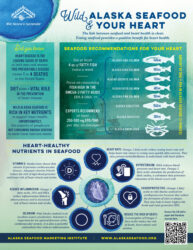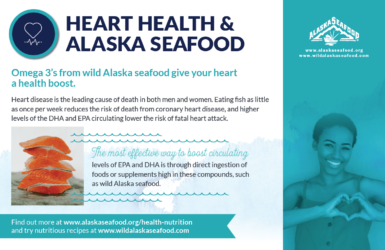Heart Health

Omega-3’s from Wild Alaska Seafood Give Your Heart a Health Boost
The link between seafood and heart health is clear. Eating seafood provides a positive benefit for heart health.
Heart disease is the leading cause of death in both men and women. Eating fish as little as once per week reduces the risk of death from coronary heart disease, and higher levels of the DHA and EPA circulating lower the risk of fatal heart attack.
The most effective way to boost circulating levels of EPA and DHA is through direct ingestion of foods or supplements high in these compounds, such as wild Alaska seafood.
Omega-3 Fatty Acids in Wild Alaska Seafood help to:
- Lower triglycerides in the blood, reducing the risk of heart disease.
- Increase levels of good cholesterol.
- Decrease blood pressure.
- Decrease risk of death after heart attack.
- Reduce side effects associated with stroke.
- Reduce inflammation.
- Consume at least two servings of fish per week.
Heart-Healthy Nutrients in Seafood
- Vitamin D: Studies have shown that vitamin D prevents cardiovascular disease. Adequate vitamin D levels reduce the risk of high blood pressure and lower risk of heart attack and stroke.
- Reduce inflammation: Omega-3 fatty acids, EPA and DHA, reduce inflammation linked to atherosclerosis and to increased risk of heart attack and stroke.
- Selenium: Wild Alaska seafood is an excellent source of selenium. Selenium is important for the optimal function of the cardiovascular system. It is also a powerful antioxidant that reduces inflammation.
- Heart Rate: Omega-3 fatty acids reduce resting heart rate and help heart rate return to resting more quickly after exercise. They also prevent atrial fibrillation in individuals with heart failure.
- Hypertension: DHA reduces blood pressure and heart rate. Omega-3 fatty acids stimulate the production of nitric oxides, a substance that promotes relaxation of the blood vessel wall.
- Cardioprotective: Omega-3 fatty acids in wild Alaska seafood are cardioprotective because they reduce the formation of clots or plaque. They also help to lower triglyceride levels and raise protective HDL.
- Reduce the Risk of Death: Consumption of Omega-3 fatty acids reduce the risk of death, heart attack and strokes.
Ready to improve your heart health?
Check out these heart-healthy recipes for Alaska seafood.
Recipes
Heart Health Research
- An analysis of 20 studies involving hundreds of thousands of participants indicates that eating a modest consumption of fish (1-2 servings/wk), especially species higher in omega 3 fatty acids EPA and DHA, reduces risk of coronary death by 36% and total mortality by 17%.
- Evidence continues to emerge to further substantiate the beneficial effects of seafood long-chain n-3 polyunsaturated fatty acids and cardiovascular disease. A review by the American Heart Association continues to recommend eating fish twice a week for a healthy heart.
For more information on heart health and seafood consumption see:



